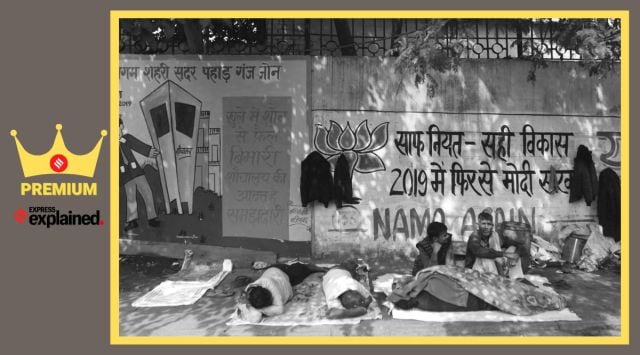India has registered a decline in the number of “multidimensionally poor” individuals, from 24.85 per cent in 2015-16 to 14.96 per cent in 2019-2021, according to a report by the government think tank Niti Aayog.
In absolute terms, approximately 13.5 crore Indians escaped poverty between the five year time period, courtesy of improvements in indicators like access to cooking fuel, sanitation, drinking water, and bank accounts, among others.

However, the report, titled ‘National Multidimensional Poverty Index: A Progress Review 2023’ showed that when it came to indicators like nutrition and access to education, the improvement has only been marginal, as these parameters contributed the most in keeping one in seven Indians multidimensionally poor.
While there continues to be a major disparity between the number of people in poverty in rural and urban areas, the former witnessed the fastest decline in poverty from 32.59 per cent to 19.28 per cent, owing to improvements in states like Bihar, Uttar Pradesh, Madhya Pradesh, Odisha, and Rajasthan.
What is multidimensional poverty?
This is the second edition of Niti Aayog’s report on the Multidimensional Poverty Index (MPI). It captures overlapping deprivations in health, education and living standards and other broader qualitative aspects of life, like child mortality, housing conditions, and other basic services such as water and sanitation to ascertain multidimensional poverty. The primary data source to arrive at these figures was National Family Health Survey-5 (NFHS-5).
Under the three broad indicators of health, education and living standards, Niti Aayog assigns specific dimensions – such as nutrition and child adolescent mortality under health, years of schooling under education, and access to cooking fuel, electricity, bank accounts etc. under quality of living. Each of these specific parameters are assigned a value to calculate what is called a ‘deprivation score’.
The deprivation score is the sum of the weighted status of all the indicators for an individual – if it is more than 0.33, only then an individual is considered multidimensionally poor.
Story continues below this ad
What is keeping Indians multidimensionally poor?
Even as there has been a significant reduction in the number of multidimensionally poor individuals, it is worth noting that one in seven Indians continue to fall under that category – primarily because poverty reduction is not equally represented in the three main indicators of standard of living, health, and education.
Within the health category, three sub-indicators — nutrition, child and adolescent mortality, and maternal health — showed only moderate improvement, the report showed.
Nutrition deprivation decreased from 37 per cent to 31 per cent, maternal health deprivation improved from 22.5 per cent to 19.17 per cent, and child and adolescent mortality deprivation declined from 2.69 per cent to 2.06 per cent.
Lack of proper nutrition contributed close to 30 per cent — the highest — in the overall calculation of India’s multidimensional poverty index. “Contributing to nearly one-third of the multidimensional poverty in India, nutrition is arguably one of the most important indicators in India’s national MPI,” the report said.
Story continues below this ad
A household is considered nutritionally deprived if any child between the ages of 0 to 59 months, or woman between the ages of 15 to 49 years, or man between the ages of 15 to 54 years – for whom nutritional information is available – is found to be undernourished. A woman or a man is considered undernourished if their Body Mass Index (BMI) is below 18.5 kg/m2.
Children under 5 years of age are considered malnourished if their z-score of height-for-age (stunting) or weight-for-age (underweight) is below minus two standard deviations from the median of the reference population. Even if a single member of the household is identified as undernourished, the entire household is treated as deprived of nutrition.
Other indicators that did not record a significant decline and aided the most in keeping Indians poor include lack of years of schooling (16.65%), inadequate access to maternal health services (11.73%), and less-than-desired school attendance (9.10%), among others.
Also, while there has been a significant improvement in access to cooking fuel, it is worth noting that close to 44 per cent of India’s population is still deprived of it. Similarly, while sanitation numbers have improved, more than 30 per cent of the population is deprived when it comes to sanitation services.
Story continues below this ad
Access to housing also remained to be an indicator where the improvement was only marginal. In 2015-16, close to 46 per cent of the population did not have such access, and in 2019-21, more than 41 per cent Indians still did not have access to housing.
All three of the above sub-indicators fall under the standard of living criteria.
How have various states fared in the multidimensional poverty index?
The good news is that the number of states with less than 10 per cent people living in multidimensional poverty doubled in the five years between 2016 and 2021. According to the report, in 2015-16 (NFHS-4), only seven states had less than 10 per cent of their population living in multidimensional poverty — Mizoram, Himachal Pradesh, Punjab, Sikkim, Tamil Nadu, Goa, and Kerala.
 Based on 2019-21 (NFHS-5) data, 14 states now have less than 10 per cent of the population living below the poverty line. It includes Mizoram, Himachal Pradesh, Punjab, Sikkim, Tamil Nadu, Goa, Kerala, Telangana, Andhra Pradesh, Haryana, Karnataka, Maharashtra, Manipur, and Uttarakhand. (NITI Aayog report)
Based on 2019-21 (NFHS-5) data, 14 states now have less than 10 per cent of the population living below the poverty line. It includes Mizoram, Himachal Pradesh, Punjab, Sikkim, Tamil Nadu, Goa, Kerala, Telangana, Andhra Pradesh, Haryana, Karnataka, Maharashtra, Manipur, and Uttarakhand. (NITI Aayog report)
However, in 2019-21 (NFHS-5), the list had doubled to include 14 states, with the seven new additions being Telangana, Andhra Pradesh, Haryana, Karnataka, Maharashtra, Manipur, and Uttarakhand.
Story continues below this ad
Except for Bihar, no other state in India has more than one-third of its population living in multidimensional poverty. However, even in Bihar’s case, the reduction in multidimensional poverty has been significant over the five year time period – in 2015-16, over 51.89 per cent of Bihar’s population lived in multidimensional poverty. By 2019-21, the figure had dropped to 33.76 per cent.
Jharkhand reduced the percentage of people living under multidimensional poverty from 42 per cent in 2015-16 to 28.82 per cent in 2019-21, Uttar Pradesh saw a decline from 37.68 per cent to 22.93 per cent, and in Madhya Pradesh, multidimensional poverty dropped from 36.57 per cent to 20.63 per cent.



 Based on 2019-21 (NFHS-5) data, 14 states now have less than 10 per cent of the population living below the poverty line. It includes Mizoram, Himachal Pradesh, Punjab, Sikkim, Tamil Nadu, Goa, Kerala, Telangana, Andhra Pradesh, Haryana, Karnataka, Maharashtra, Manipur, and Uttarakhand. (NITI Aayog report)
Based on 2019-21 (NFHS-5) data, 14 states now have less than 10 per cent of the population living below the poverty line. It includes Mizoram, Himachal Pradesh, Punjab, Sikkim, Tamil Nadu, Goa, Kerala, Telangana, Andhra Pradesh, Haryana, Karnataka, Maharashtra, Manipur, and Uttarakhand. (NITI Aayog report)




































